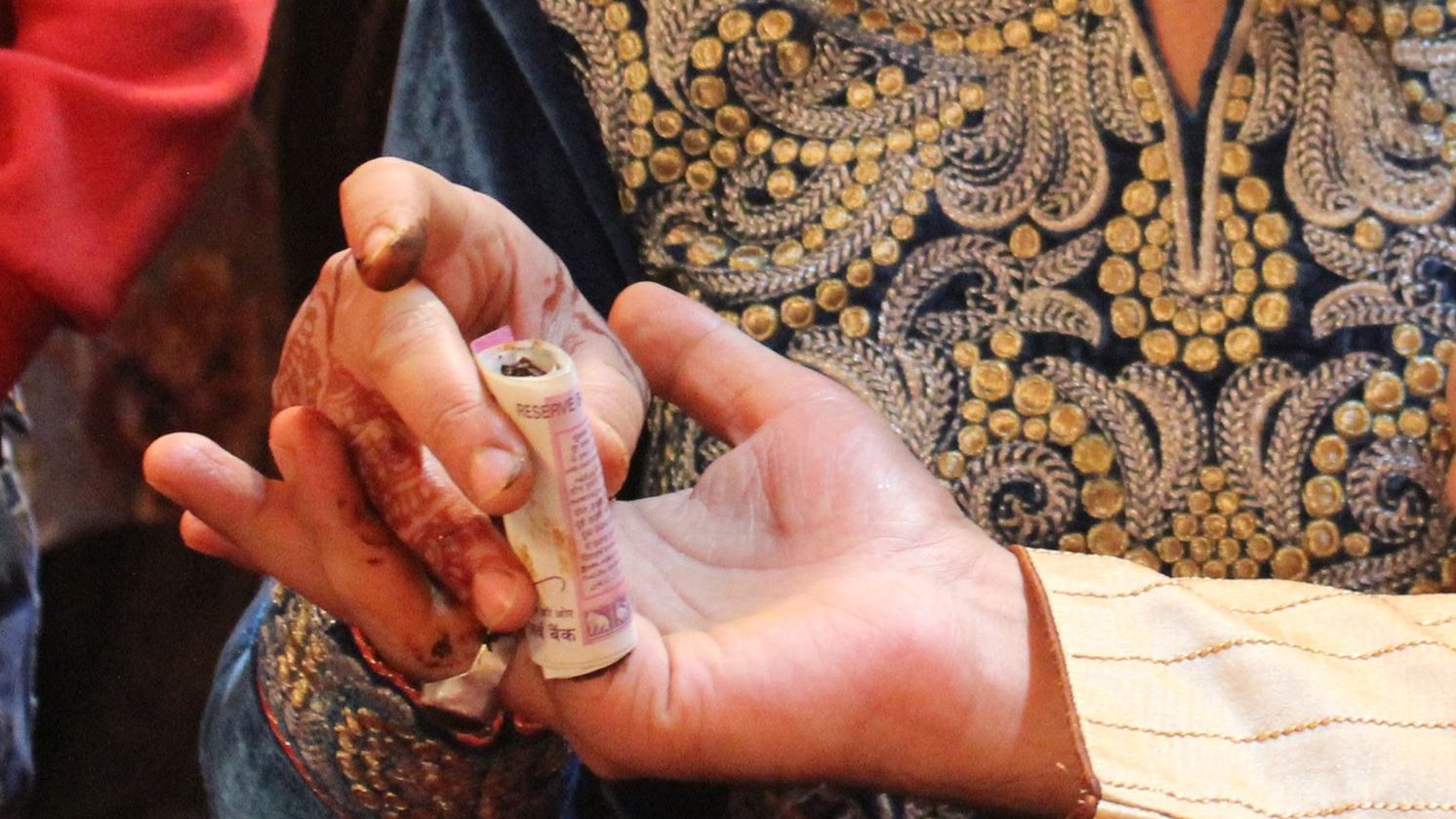When you think about Kashmir, the things that come into your mind are its cool weather, Srinagar’s serene shikara rides and the floating market of Dal Lake. The list continues with the majestic mountains and the lush green valleys which resemble white and green sapphires embedded in a crown. Everyone who knows about this paradise wants to visit at least once in life.
Rarely, anyone thinks of Kashmiri weddings, which are an exquisite event in itself. Coupled with Kashmiri traditions and culture, we assure you that our Kashmiri weddings are as much as alluring as anything about Kashmir or Kashmiris itself.
If you are attending a Kashmiri wedding for the first time or you are curious about Kashmiri weddings in general, allow us to present a gist of this grand celebration i.e. a Kashmiri Muslim wedding.
Wedding Ceremonies
Kashmiri wedding functions are held separately for the bride and groom; two days on the bride’s side and three days on the groom’s side. The couple meets on the day of baraat only.
The festival is grand in every aspect — the decorations, the tents, the songs and dances accompanying it, and obviously the food.
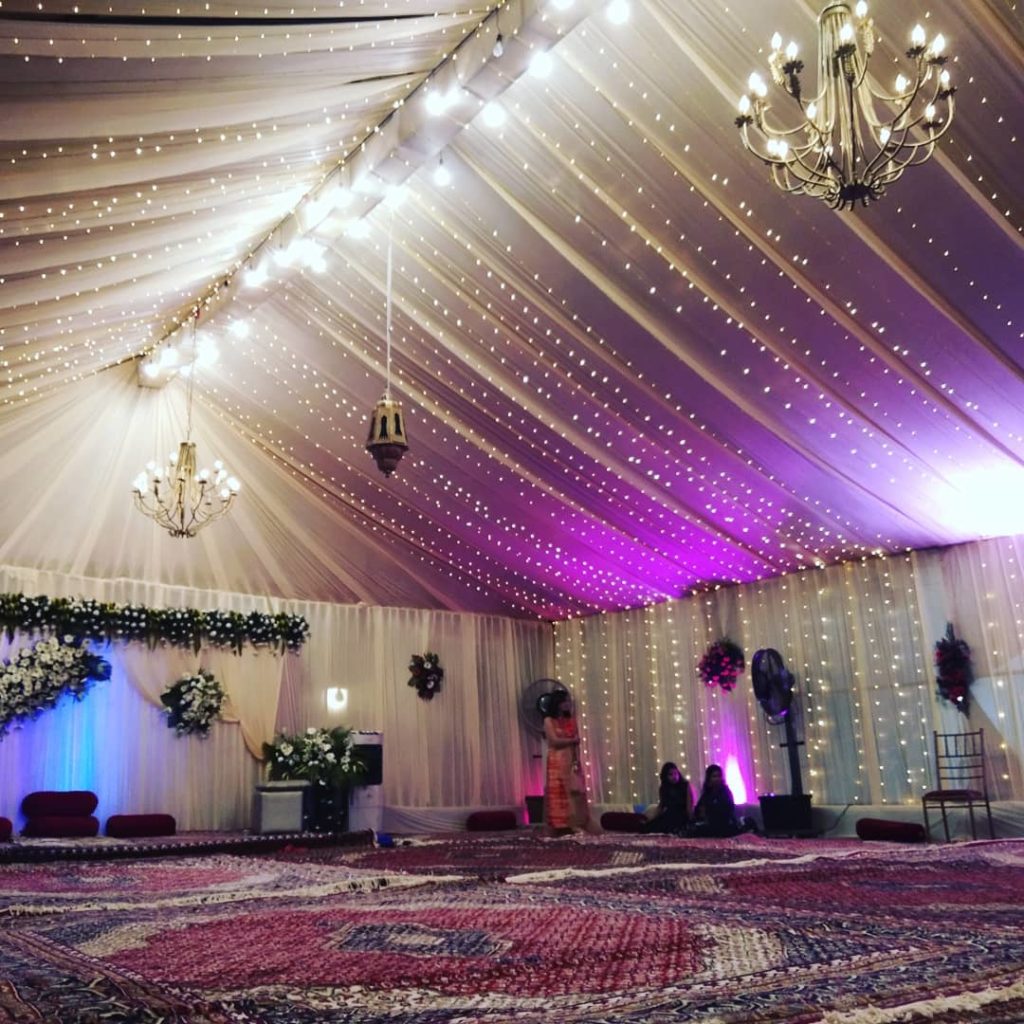
The following rituals and ceremonies take place in the Kashmiri weddings.
Also Read: Real wedding stories from Kashmir.
1. Malmaenz
The celebration starts off with Malmaenz ceremony where the young women of the house tie the bride’s hair into little braids. Then, these braids are undone by the elder women while Kashmiri folk songs are sung. Only very close relatives and friends are present on this occasion.
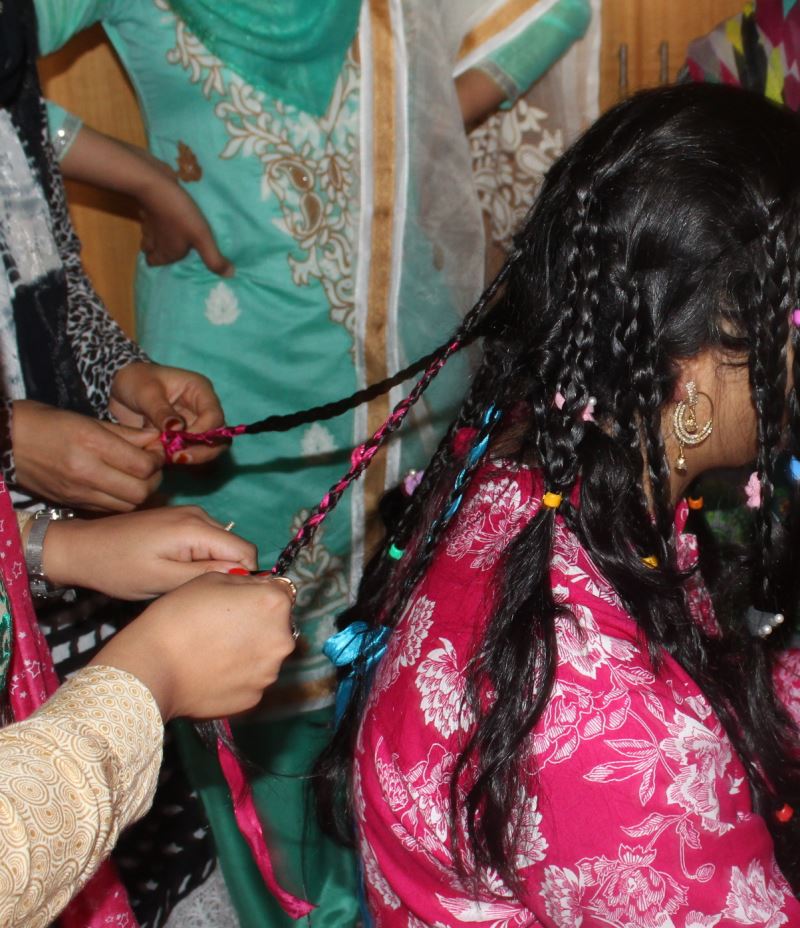
The ceremony is held for brides only and now many people prefer to skip it. Instead, brides now apply the mehndi on this day itself.
Fun Fact: This ceremony doesn’t make to the wedding cards.
2. Maenzraat
Meanzraat takes place in the night following the Malmaenz ceremony. It is also known as Mehandiraat. There is no deception here; it is the usual Mehandi ceremony in which Mehandi or Heena is applied on the bride’s hands and feet.

But for the groom, it’s different. Mehandi is applied on his little finger only, which is wrapped with 500 or 2000 rupees note as a sign of good luck.

Before the mehndi ceremony of the groom begins, a few girls from the groom’s family visit the bride’s home with beautifully decorated tokris and trays having the shagun mehandi. The girls apply the mehandi on the fingertips of the brides, which is left undone by the mehandi artist particularly for this ceremony.

The girls also bring a mehandi cake for the bride. The cake is cut in the presence of the girls and relished by all. Usually, there are two cakes as the bride’s family also gets one. The groom also cuts a cake at his mehandi ceremony. Depending on the preference of the host, you might savour any type and flavor of the cake.

The ceremony is elevated by the Kashmiri Gyawun and wanwun sung by Kashmiri ladies using instruments like tumbaknaer. Many times, you will find a professional wedding singer too.

During the day, a grand feast is usually held for male friends and family from the bride’s side.
3. Yiniwol
After the Mehndiraat, comes the Yiniwol. It starts with aab sherun ceremony for the bride followed by Nikkah and then a grand feast, and finally the baraat.
Find Best Wedding Vendors in Kashmir
Bridal Wear, Cards & Invitations, Favors & Gifts, Groom Wear, Makeup Artists, Mehndi Artists, Middleman, Music & Singers, Photography, Planners & Decorators, Trousseau Packers, Venue & Halls
Here are the details about each ceremony.
a. Aab Sherun
In the morning following the Meanzraat ceremony, Aab Sherun ritual is held. It is a ceremony in which the bride takes bath and wears a Pheran, a traditional Kashmiri dress with tilla work done on it (embroidery of silver and golden thread). Then she offers two rakats of namaz and recites the verses from the holy Quran. Aab sherun is usually followed by Nikkah (more on that below).

b. The Food
On the bride’s side, a grand feast is held for the women during the day. The lunch is preceeded by Kehwa and shirmal.
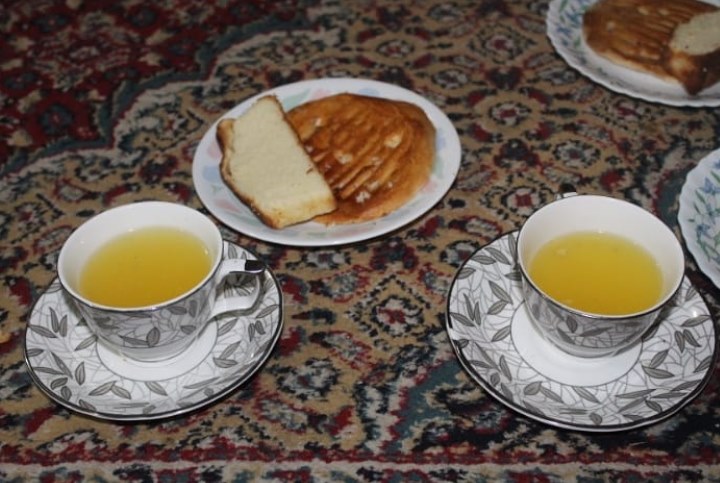
c. Yiniwol Day for Groom
On the groom’s side, the day starts with the ceremony where the groom is given a haircut in the presence of all the female relatives who sing songs during the ceremony. Later, a grand feast is held for distant male folks as the close relative will accompany the groom in his baraat.
d. Baraat
After the feast is over, preparations start for baarat. The bride’s family makes special arrangements for food (mahraaz saal) and décor. Also, there is a special platform known Masnand made of finest silk made just for the groom. The baraatis usually arrive anywhere between 8-11PM. Sometimes, Nikkah takes place at this time.
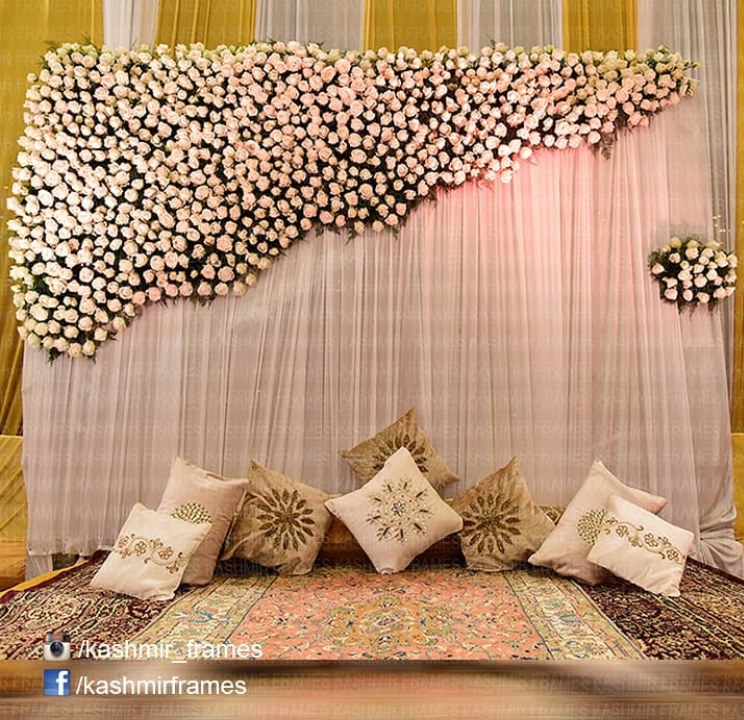
While some prefer to keep the baraat simple and only take around 4-10 people, usually the baraatis range between 20-100.
e. Rukhsati
After the Mahraazsaal is over, the bride bids final goodbye to her family members and moves with her husband to her new home also known as Waeriv (Sasural) in a well-decorated car. Rukhsati is also known as vidai or bidai.
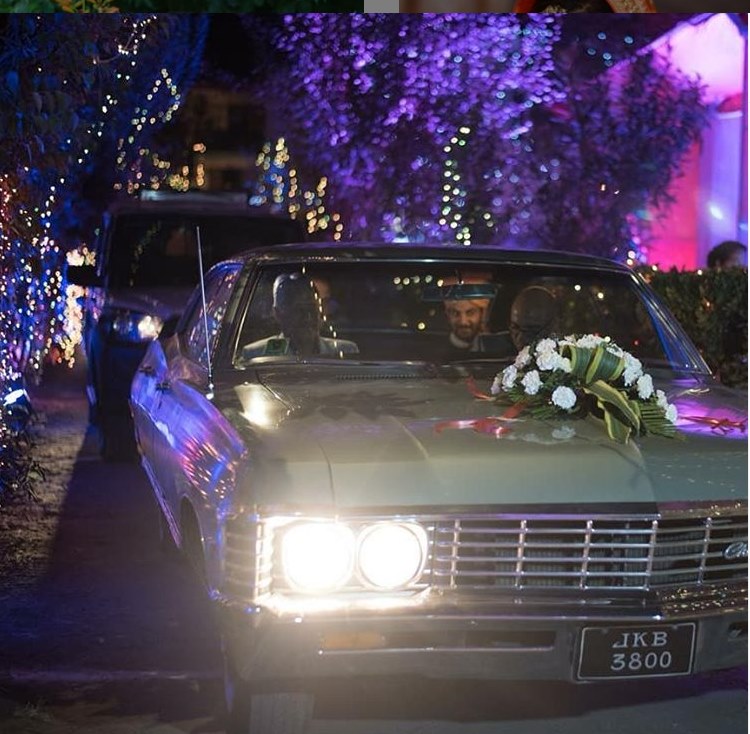
She is accompanied by a few close relatives and friends who carry her trousseau usually having traditional copper items such as dry fruit box, quran rehal, and also her gold jewellery. They make her comfortable in the new home and then go back within half an hour. This ceremony marks the end of the two-day event for the bride’s family.
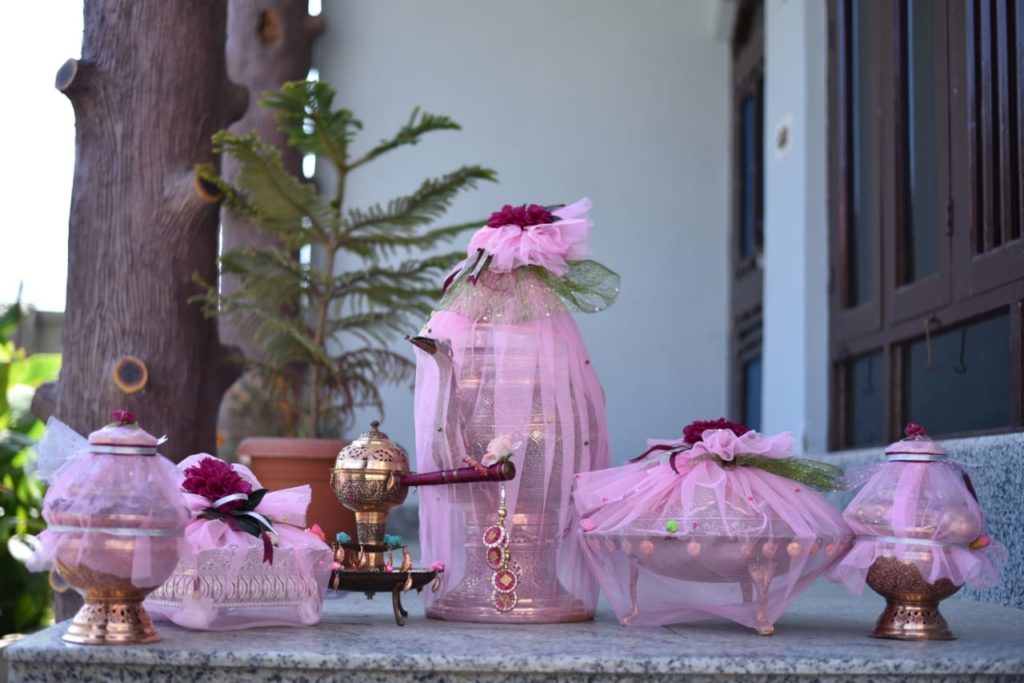
4. Walima
The day following the baraat is known as walima. It starts with a custom in the morning where the sister of the groom takes tea for the newlyweds. Then, the brother of the bride visits her with a traditional samovar usually filled with dry fruits.
During the day, a feast is held for the women relatives of the groom. The number of people can go anywhere between 100-500 or even more. While the invitation cards mention the time as 2 PM, the lunch is usually served anywhere between 3-7PM. Be prepared.
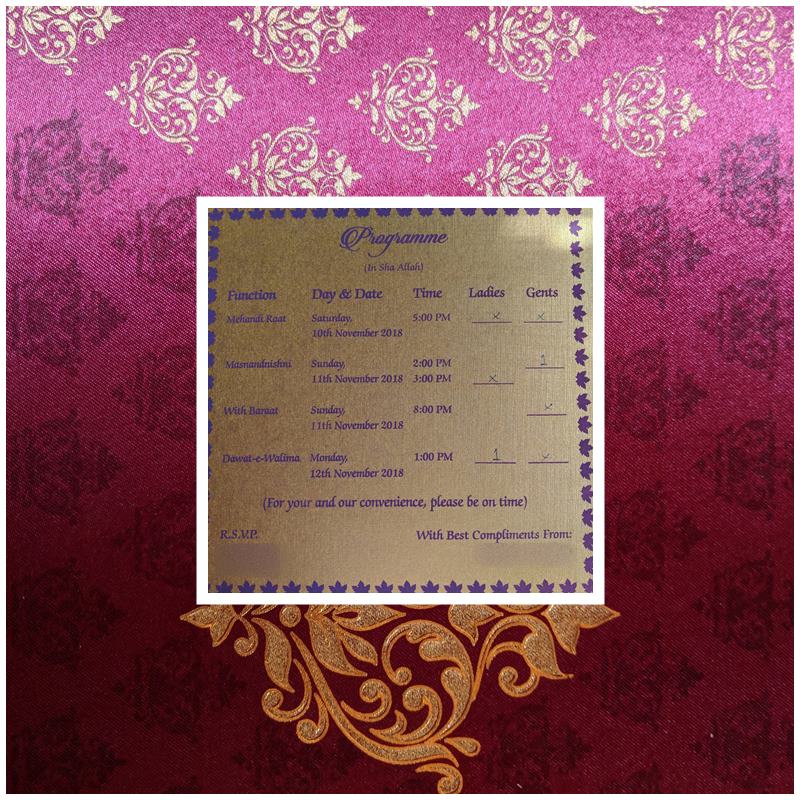
Nikah Khawaani
While Nikah is the most important part of a Muslim wedding, it is given the least importance in Kashmiri weddings. It may have either taken place before the wedding on the Nikkah-nishaen (engagement ceremony held months before the wedding) or takes place on the wedding.
There is no specific time for Nikkah. It is either carried out in the morning of Mehndiraat or Yini Wol (baraat). Sometimes, it’s the first thing that takes place after the Mehraaz (groom) arrives with his baraat.
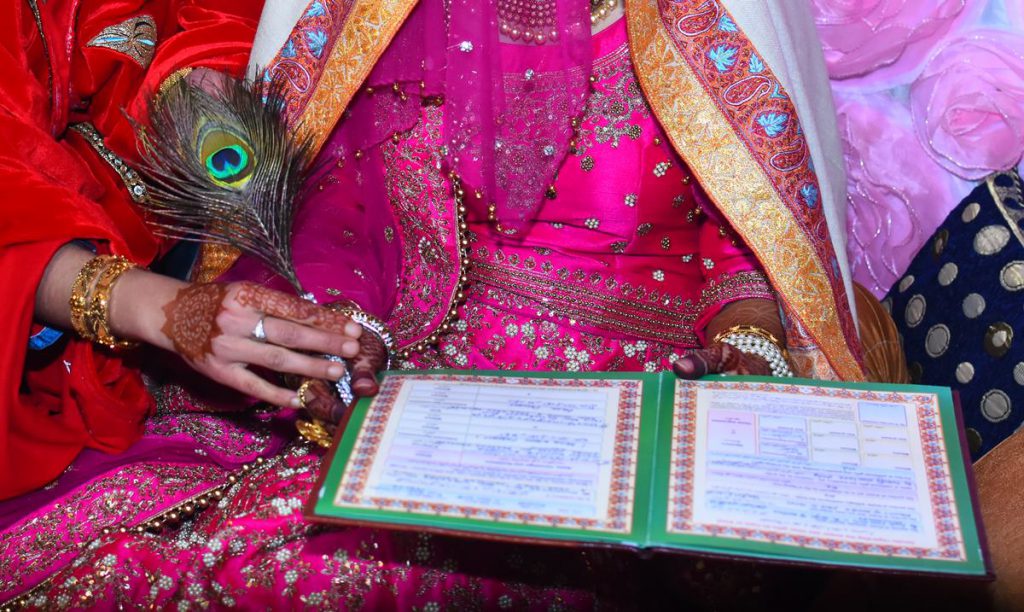
The Nikkah usually takes places in the bride’s house. There are two types of Nikkah – Wakaltan Nikkah and Asaltan Nikkah.
a. Wakaltan Nikkah
In this type of Nikkah, the bride and groom are in their respective homes. The ceremony begins by asking the groom the consent for the marriage. Usually done by the close relatives such as maternal or paternal uncles of the groom (who are known as wakeels).
Then, these relatives visit the bride’s home along with the Qazi. Their also, the paternal and maternal uncles of the bride act as her wakeel. They ask for her consent and tell her all the details of the marriage and the Mahr received (gifts from the groom). Once both have agreed, Nikkah is done.
b. Asaltan Nikkah
This is the one you would have seen on TV where both the groom and bride are present and there is a curtain between them. The Qazi recites the Quranic verses, asks for the consent from both the sides, and prays for the newlyweds.
What to wear for a Kashmiri wedding
Amidst the ceremonies and cheerful hustle-bustle of guests, you might notice that women change their dress twice a day, each one better than the last. Obviously, the bride looks most gorgeous.
You can wear traditional party wear clothes such as shalwar kameez, lehnga, sharara, gown, etc.
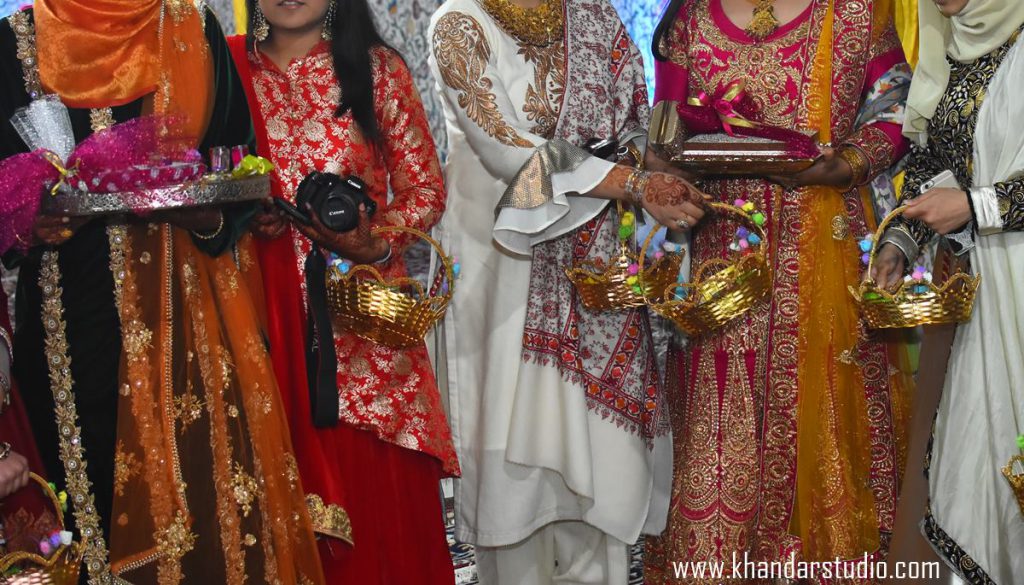
Wedding Feasts and Food – The Wazwaan
Kashmiri weddings are all about the food where the traditional wazwaan is served. Even the day of the wedding is set according to the availability of the waza (chef who prepares wazwaan). The meal comprises of different varieties of dishes ranging anywhere between 10-40. Lamb is used predominantly along with the chicken. You will find only 2-3 vegetarian dishes.

Let’s get to know wazwaan and the feasts a little bit.
1. Preparation of Wazwaan
Preparation of wazwaan takes a long time and that is what makes it so special. It’s delicious beyond your taste buds can imagine! You might notice there are a lot of chefs beating the meat with a wooden hammer. But why? Because it enhances the taste of the meat.
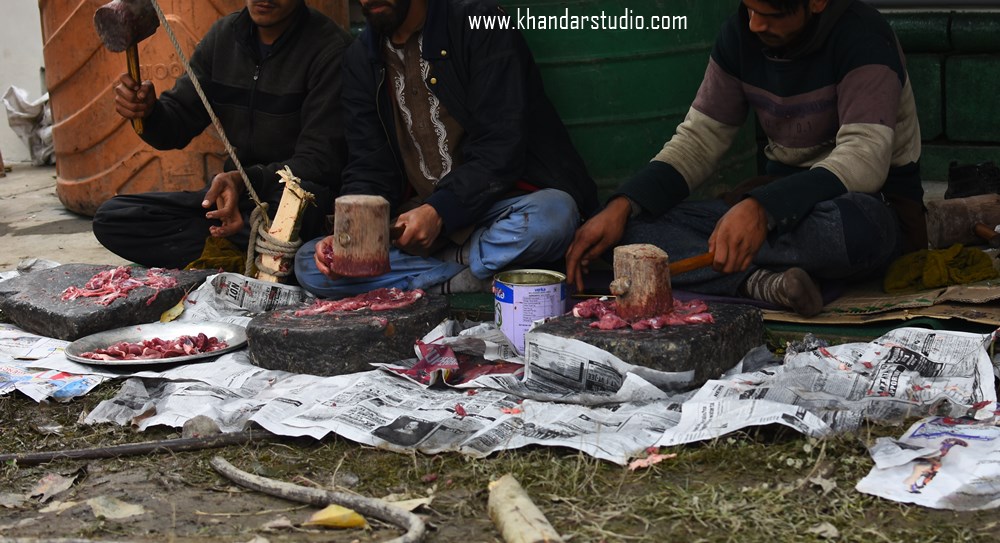
Wazwaan dishes are preferably cooked in nickel-plated copper vessels. Old fruit tree wood is used for fire. The cooking takes place under the supervision of Vaste Waza (master chief) who is accompanied by his team. The Mawal flowers or Kashmiri chilies are used to give colour to these delicacies, also adding some flavour to it.
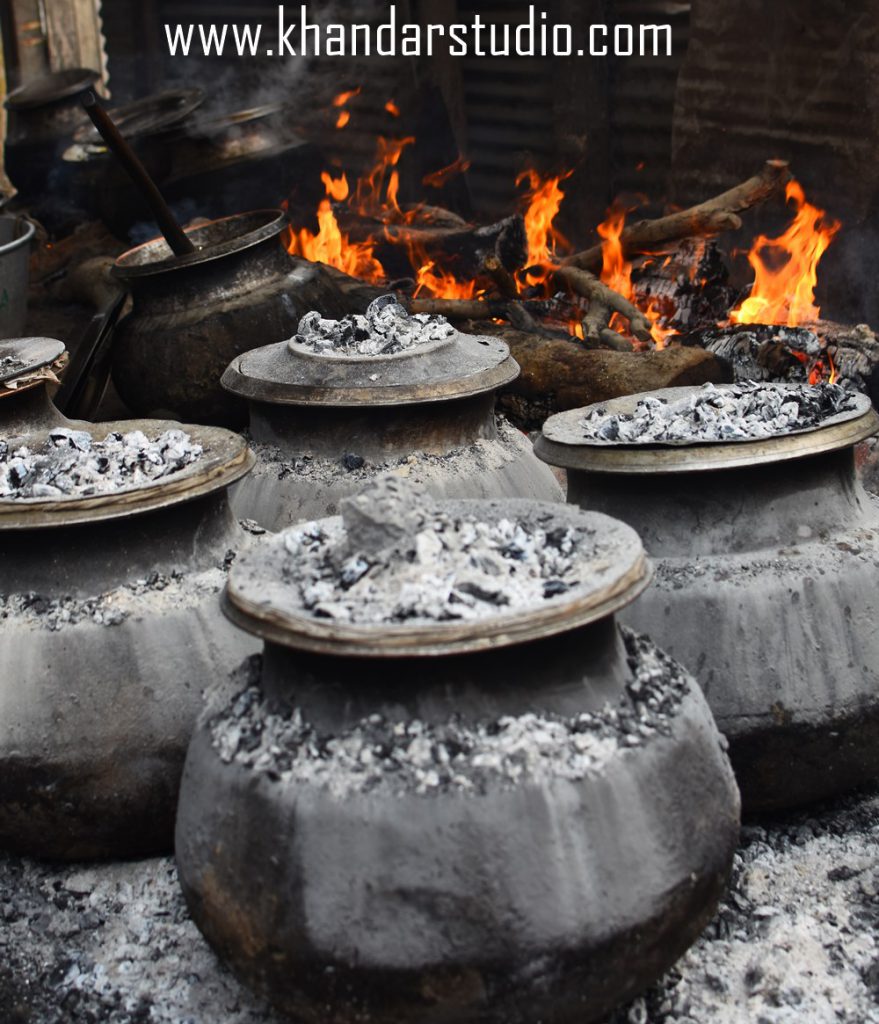
Fun Fact: The wazwaan is so special that the family is judged for the taste of the food served at the wedding for years to come.
2. What Makes Kashmiri Wedding Feasts Special
To start with, you don’t eat alone. You are supposed to sit with four people who will share the wazwaan with you in a trammi. Now, some people prefer to have buffets for it reduces the waste in weddings.
As soon as the preparations for the meal begins, groups are formed having 4 people. Next, attendants will bring multiple Tash Naers (Tash fashioned like a teapot and Naer is a basin). They are taken near everyone to let the guests wash their hands.
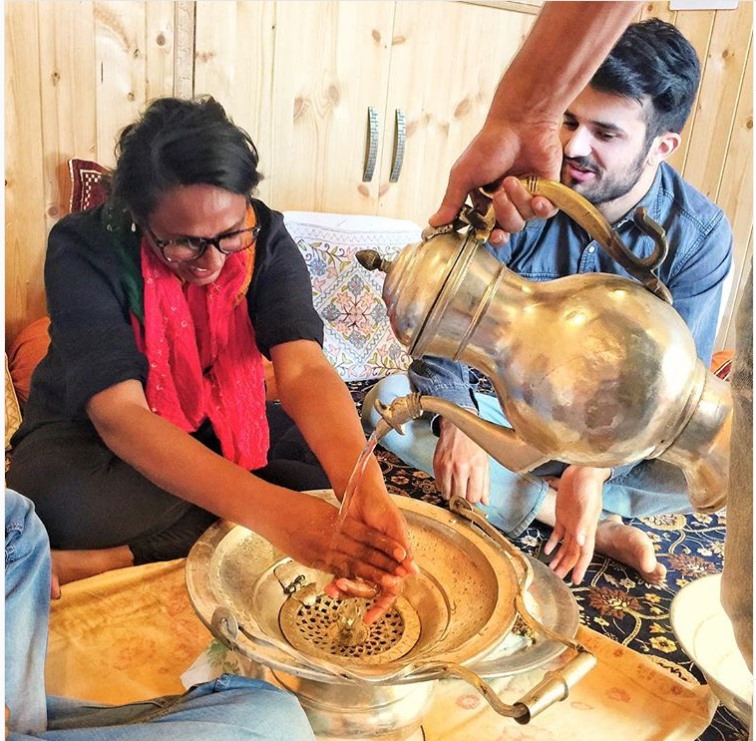
Once that is done, long sheets are spread (dastarkhans – cloth or disposable). Then the attendants will bring in the Traem or Trammi (beautifully engraved copper platter) covered with Sarposh (a lid that keeps the wazwaan warm) and serve to the groups one by one.
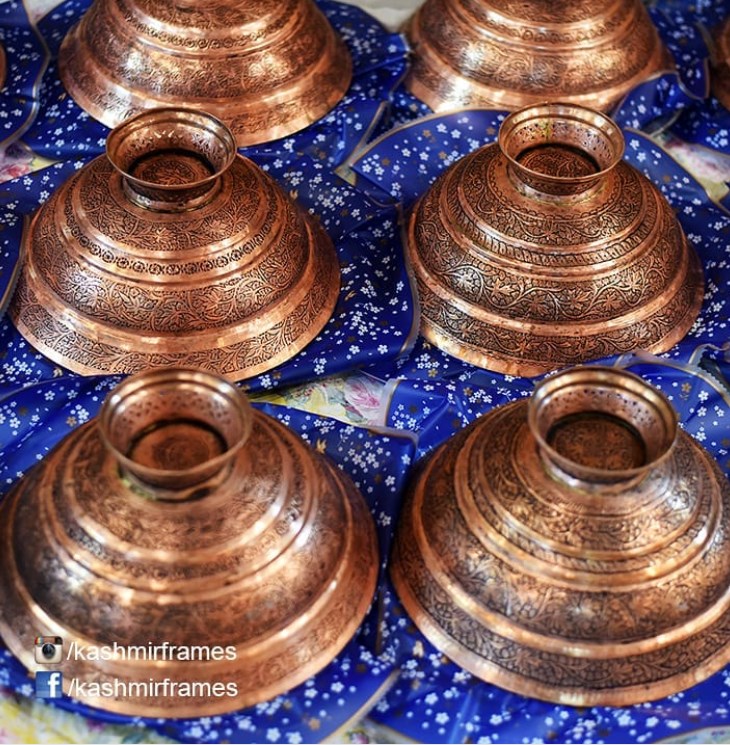
There are few things you will notice:
- The men and women eat separately while sitting.
- You are supposed to eat with your hands and not with spoon, fork, or knife. So if you are not taught to eat with your hands, it will be wise to learn it before attending a Kashmiri wedding!
- People will put their share of wazwaan in bags and take it with them. It’s encouraged to reduce the wastage of food.
What’s Served in Wazwaan
You might be wondering what is present under the Sarposh, we talk so highly about? Well, there are many dishes. Actually, the list of dishes is so long and diverse that we might need another article for that! So, let us present you a gist.
There are two ways the dishes are served. Some are already present on the Traemi while other dishes are served later by Waza.
Dishes Present on Trammi
A heap of rice is served along with two pieces of Seekh kebab, four servings of methi, and then there are other meat dishes namely Tabak-maaz, Daeni Phoul, and Waze chicken. At special occasions, you will also find shami kabab.
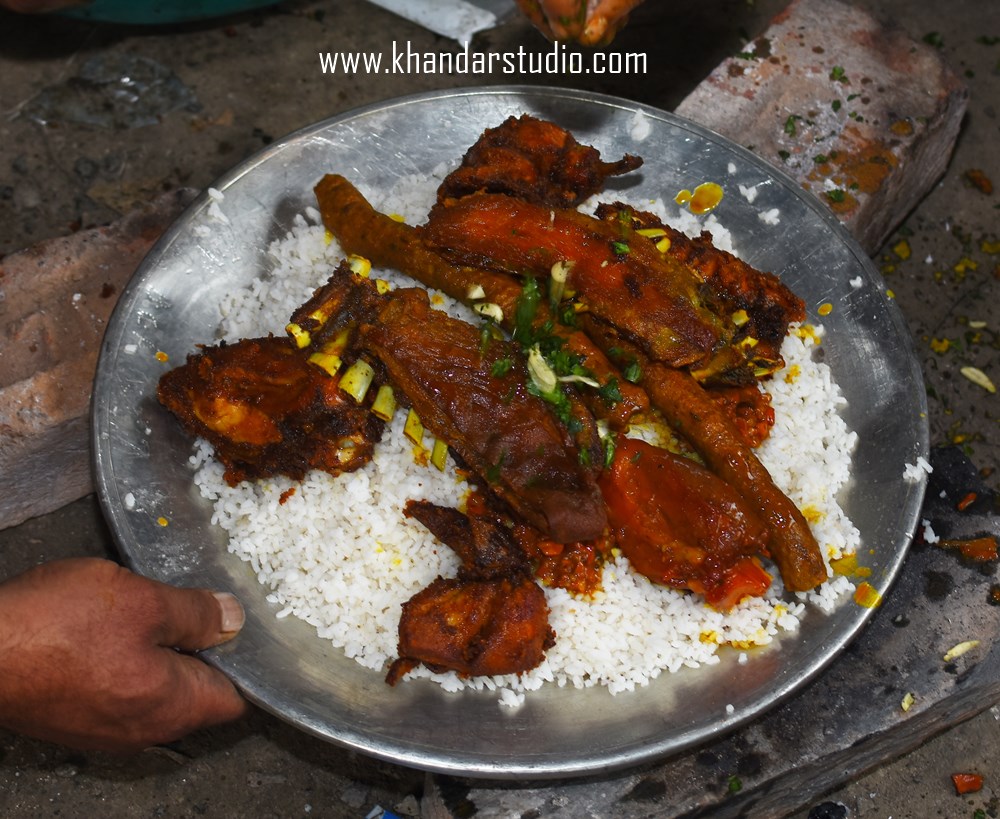
Wazwaan Dishes Served Later
After the trammi is served and people start relishing the meals, more dishes follow. To begin with, four ristas (a red coloured Kofta in red gravy) are served by waza in each trammi followed by four pieces of Rogan Josh, Daniwal Korma, and Mirchi Ka Korma (for spice lovers). Other dishes include Lahabi Kabab, Aab ghost, Pulao, tamatar chaman (paneer) and much more.
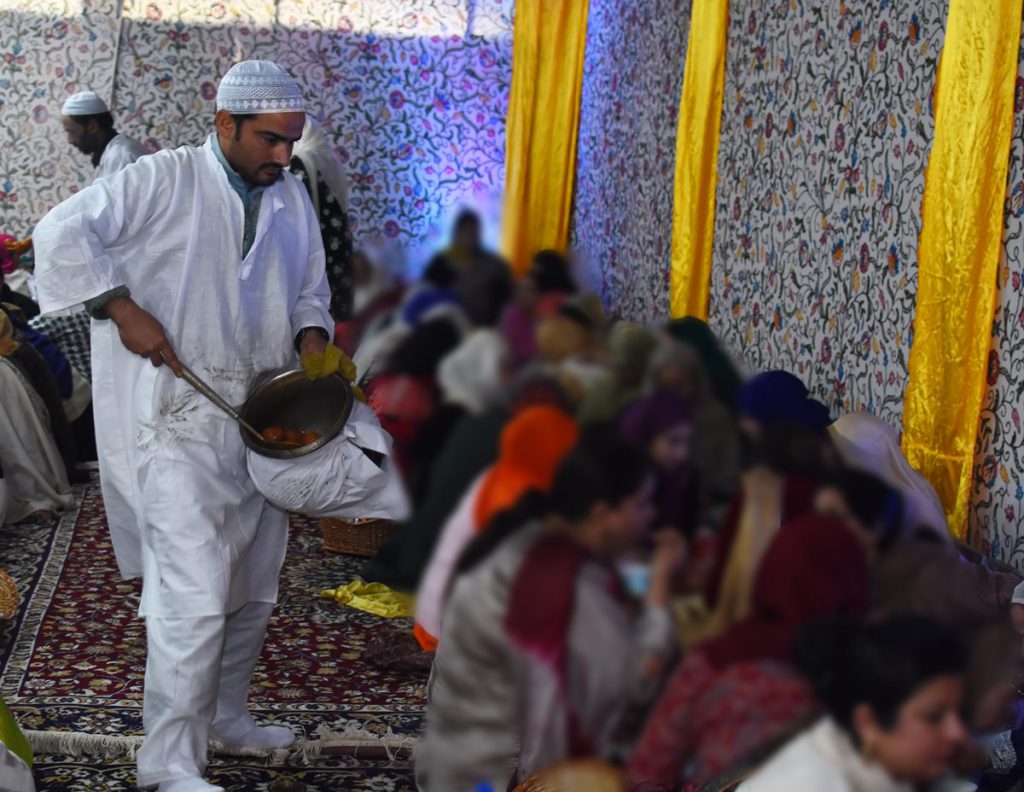
Different types of Chatnis and salads are also served in plates. The finishing dish is called Ghustaba, which is essentially a large ball made of minced meat. Finally, the dessert Firni marks the end of wazwaan.
Enjoy the Wedding!
Kashmiri weddings can be called as festivals. We hope you get the chance of attending our grand weddings, and after reading this article we are sure you won’t miss the chance! As always, we look forward to your comments.
– Join our Facebook group (Khandar Studio) to buy and sell wedding products in Kashmir.
– Want to sell or buy used bridal lehnga in Kashmir? Join Mahrin group.
-Are you looking for a Kashmiri bride or groom? We can help you in this. Join our Facebook group (Khandar Studio Matrimony).
Pssst!… We are accepting guest posts regarding weddings in Kashmir. Have anything interesting to share or just need to rant? Drop us a message.
Author: Nandan Singh

